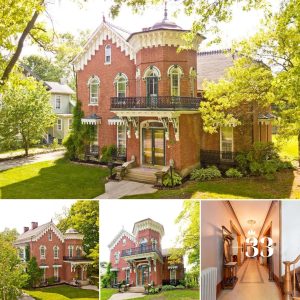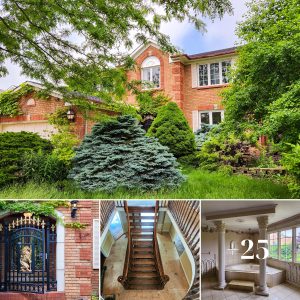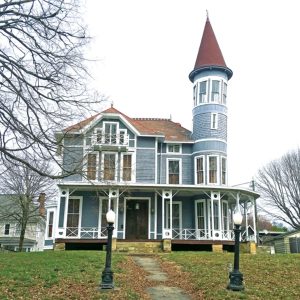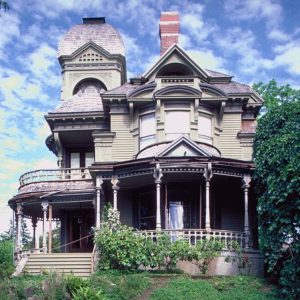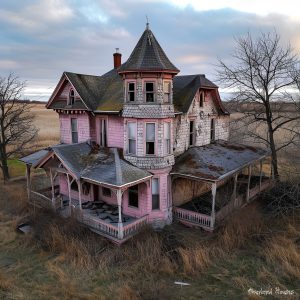
Fambro-Arthur House | Dallas County, Alabama | c. 1840
In 1840, this home was constructed at the center of a river town in Alabama by William Fambro. It was one of a few like this style in town, but today is the only antebellum house that still stands in a community where the people have disappeared. But as I researched the property, I was able to uncover the stories of the lives of many generations of Alabama citizens hiding inside these walls. Each one adds a fascinating chapter to the story of this place and helps to bring a ghost town back to life for a moment.

Cahawba: The First Capital of Alabama
Cahawba (Cahaba) was the first permanent capital of the state from 1819-1826 due to its advantageous location at the confluence of the Cahawba and Alabama Rivers. In these early days when roads weren’t developed, the rivers were the best connector from inland Alabama to the larger markets in Mobile and Montgomery. At the site of a native village that had been abandoned, a town was drawn and lots were carved out in 1819 by surveyors.

Many homes were built during this era, from large mansions to more modest shelters, along with an impressive courthouse, an academy, and numerous businesses. From the antebellum era, only two still stand today, one of which is the Fambro-Arthur home.

William W. Fambro
In 1805, William W. Fambro (Fambrough) was born in Davidson County, Tennessee but by age 10, he had been orphaned. As was common in those days, he was appointed a guardian who raised him as a ward and apprentice in exchange for work until he was of legal age. William’s guardian worked on riverboats, which might explain how he ended up in the bustling river town of Cahawba, Alabama. The community was booming until devastating floods and disease from mosquitos plagued the town so much that the capital was relocated to Tuscaloosa. When it was moved in 1826, many residents left- actually taking their homes with them, leaving many lots in town empty and available.

During his young adult years when the capital was still at Cahawba, William had the opportunity to interact with many attorneys who had offices that lined the main street in town near the courthouse. According to one story about him, William was able to secure a position as an apprentice at one of their offices. The flooding concerns didn’t seem to worry William who stayed in Cahawba after the capital relocation and according to records from 1832, he had opened his own law practice in town.
A boom would return to Cahawba in the 1840s when the town, which had been largely abandoned, found renewed activity as river shipping needs continually increased. Cotton crops surrounded Cahawba and their yields needed to make it from inland Alabama to the bigger markets in Mobile where it was shipped to the European markets. Cahawba’s location made it ideal for business ventures and warehouses were constructed in town. William found success quickly in this new business landscape and with that success, contributed in 1839 to the construction of the first church ever to be built in Cahawba. In 1840, he purchased lots 9-12 in town, and at the center of his properties, he built this home for himself on Lot 11, although a portion of the home might have already been on the site and expanded. In 1842, he married Elizabeth Jacob.

The Fambros of Cahawba
Mr. and Mrs. Fambro were very involved in the community in a variety of ways. As an attorney, William also served as Justice of the Peace in 1838 and 1841 and town constable. He was also on the board of trustees for the Boys & Girls Academy which was located just one block away from his home. He and his wife Elizabeth (a former teacher) never had biological children so they allowed rural students, teachers, and principals to board at their home during the school term over the years.

Mr. and Mrs. Fambro also opened their home to a young girl named Mary who had a tragic childhood and had been orphaned like William. Mary Johnson was the daughter of a riverboat captain who had died in an accident on the Mississippi River when she was just a baby. Another captain saved the child from drowning and raised her until she was 8 when he decided that she needed to have an education and a house on solid land. He asked William and Elizabeth if she could attend their academy and board with them. They loved her so much that they adopted the young girl and raised her as their own.
The Fambro Mill
According to newspapers, by 1850, William also owned a sawmill that supplied pine, white oak, hickory, beech, poplar, and cedar and filled orders for cabinet work. The operation was successful but demanding, so in 1853, William and Elizabeth relocated outside of the town of Cahawba to live closer to the site of his mill operation, about six miles away. In August of that year, he advertised his townhome for sale describing the house and property as:
“Large and conveniently constructed, having 12 rooms beside a hall, 2 porticoes, and a back gallery. All the necessary outhouses are attached, including a fine garden, an orchard, and a house lot. The place is handsomely decorated with shade trees and ornamental shrubbery. An artesian well is now being drilled.”

The Civil War Era
In the years leading up to and including the Civil War, the house changed owners a handful of times, including the Troys, the Williams, the Portises, and the Bells. At the end of the Civil War when the South surrendered, Wilson’s Raiders were rumored to be heading to Cahawba. According to legend, it was here in the artesian well on the property that: “gallons upon gallons of fine brandy, wines, cordials, and cherry bounce were consigned to the waters of the artesian well to prevent its falling into the hands of Yankee soldiers.”

Ezekiel Arthur
But the next (and last) family to live here would add the most fascinating chapter to the history within the walls of this home. In 1854, Ezekiel Arthur was born into slavery in Arkansas. At the very young age of 3, he had already been sold away and appears in records in Cahawba, Alabama. I found a record where he is listed as the ‘child servant’ of Mrs. Arthur, his enslaver who was sponsoring him in 1857 for baptism at the Episcopal Church in Cahawba. He spent the rest of the pre-war years enslaved in the little river town of Cahawba, but after the war, he was a free man with a mission.
In the years he was enslaved, Ezekiel was sold 3 times and in each instance, his name was changed, further separating him from his family. Not knowing anything about his own family, after Emancipation, he took the last name of the last family who enslaved him (Arthur) as was common for many freed people during this time. But he longed to be reunited with the family he had been ripped apart from, and for the next two decades, he searched and traveled the southern states looking for his mother and sisters who had been sold off to different plantations.
It’s unclear if he was able to find all of them, but according to the story, he returned to Cahawba, Alabama in 1894 with some of his sisters. Ezekiel paid $2,000 to purchase this home for them to live together. By this time, most of the town was occupied by freedmen who moved into town after the end of the war after the white residents left.
Ezekiel married a woman named Mary and became a farmer, a land owner in town, and a successful family man with 4 children. On their property, he and his son Sam farmed corn, cotton, and sugar cane that produced syrup they sold to cafes in nearby towns. They had their own hay press, their own mules, and a mill as well.
After Ezekiel’s passing, his son Sam continued to farm the land. In 1944, Sam married a woman named Mattie whom he met in Selma, and convinced her to move to his property in Cahawba. Sam and Mattie Arthur would have 2 daughters that they raised here until Sam died at the age of 68. Mattie would continue to live the rest of her days here until 1995 when she passed away at age 80. The home has been empty ever since.
Architectural Notes
The house is thought to have been built in 1840, however, only half of the house frame is built of sawed lumber, while the other half appears to have been hand-hewn. Since William Fambro had his own mill when he built this house, there is speculation that a portion of this house was built before 1840 and then expanded when William bought the lot.
The other antebellum residences that were once scattered around Cahawba have all disappeared, except for the Fambro house. This raised-cottage style of home was probably popular around the town of Cahawba in the middle 1800s due to the frequent flooding the town endured, but served other functions over time as the home changed hands.





Visiting the Fambro-Arthur House At Cahawba
The Fambro-Arthur house is one of only two antebellum structures still standing in the town of Cahawba, Alabama. The house was donated by the Arthur Family to the Alabama Historical Commission which is working to stabilize the structure from collapsing. Visitors currently cannot be allowed near the house because of the danger of collapse. Temporary emergency measures have been taken to shore up the foundation and efforts to stabilize the structure are underway.
You can visit the house and walk around the front and sides, however interior access is prohibited.
If you’d like to support the efforts to save this historic structure, you can learn more HERE. The ‘ghost town’ is maintained and operated as Old Cahawba Archaeological Park and is only open to the public during designated operating hours, you can find more information about visiting the park, please visit their website HERE.

